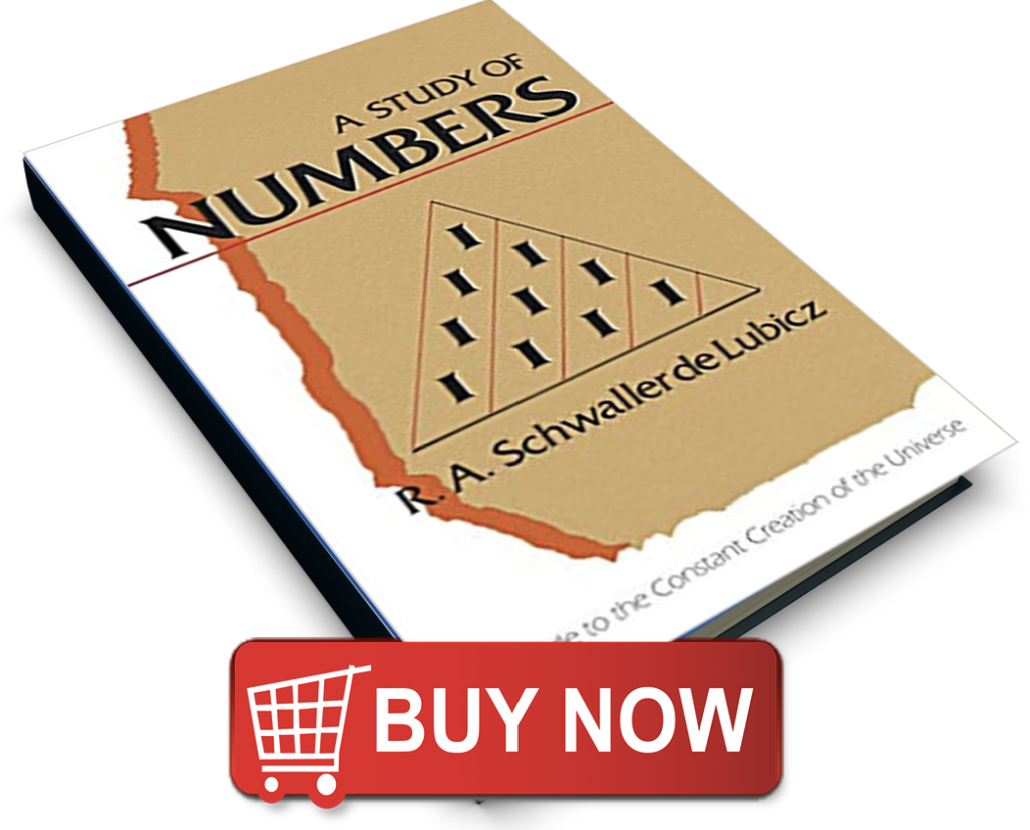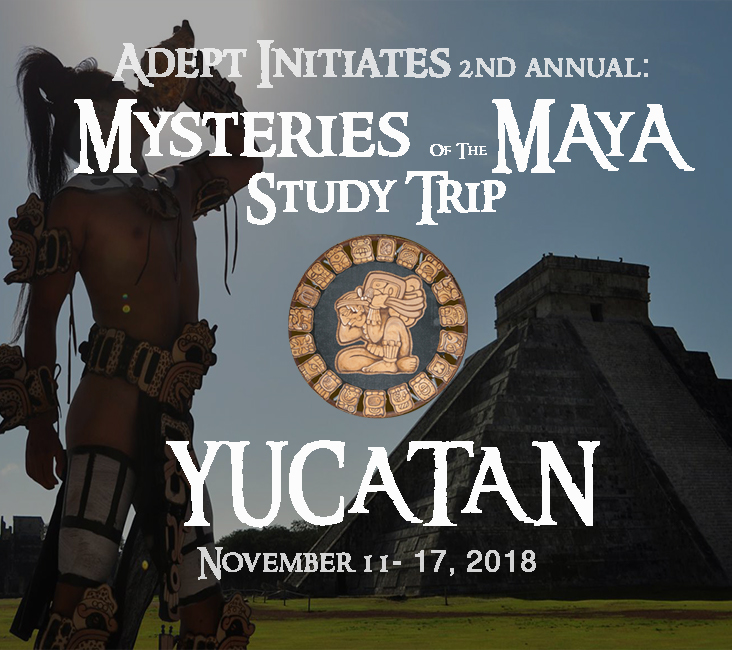The Secret Teachings of the Maya Ballcourt at Chichen Itza
There were thirteen ball courts at Chichen Itza. Today most of them are in ruins but If you are entering the plaza from the west by using the public entrance you’ll notice the grand ball court to your immediate left. At a whopping 551 feet in length and 230 feet in width its an impressive site to behold. The main playing area is flanked by two parallel platforms and at 26 feet in height they tower over the landscape making this enormous ballcourt hard to miss.

What you will miss is your opportunity to experience the acoustic phenomana hidden in the walls, the esoteric understanding of the symbolic game depicted on them, and several important secret teachings. But If you are traveling with the right symbolist tour guide or group by your side, all this and more can be revealed when exploring the Maya ball court at Chichen Itza.
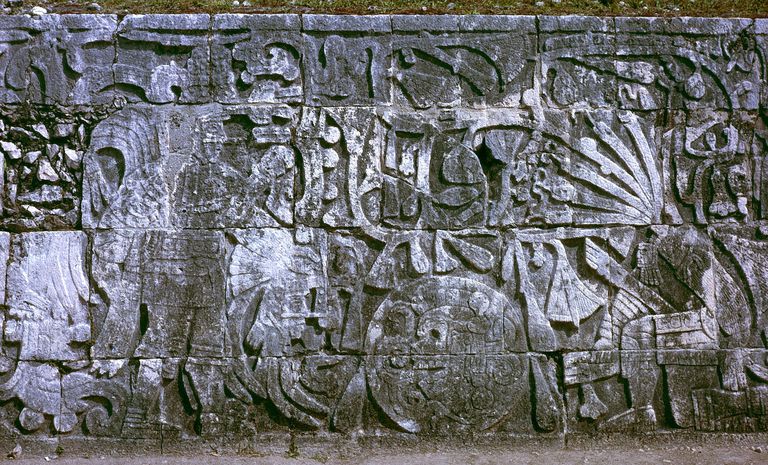
The Maya Ball Game
You may have already heard about the controvesial ball game, where if you were a Maya warrior and captain of the losing team; losing the game meant losing your head – literally.
On the other hand there are some experts who believe the winner was awarded decapitatation rites as part of a ritual sacrafice. The obvious question to ask then becomes, ‘What do you stand to gain from losing your head?’
To widen our view we must give consideration to the rule of reciprocation, where we must give before we receive. In our case a debt to karmic law is paid by losing our head and thus sacrficing our blood rengerating the earth for the gods in order to become one. So In this view it would have been considered an honorable way to lose your life.

Either way by accepting these overt understandings of a sacraficial ball game, there is yet something more we stand to lose – the symbolist intepretation. There is an important mystery school teaching at the grand ball court of Chichen Itza that should not be lost, because the ancient Mayas high wisdom can be applied today in order to help improve our modern living.
Not all is lost!
For decades archaeologists have been trying to understand the purpose of the mesoamerican ball courts. Mayanists and epigraphers alike are in constant debate over the various theories. They are still not certain if it was the winner or loser who experienced decapitation in ritual sacrafice – or if it even really took place. Could the headless hero be a metaphor for conquring one’s lower self? This motif for overcoming one’s ego in well established in the western esoteric tradition.
However, based on this unsettled conflict and limits imposed by academic discipline the information being transmitted to tour guides may only maintain one of several views. Two tour guides at the same site may tell you two entirely different things.
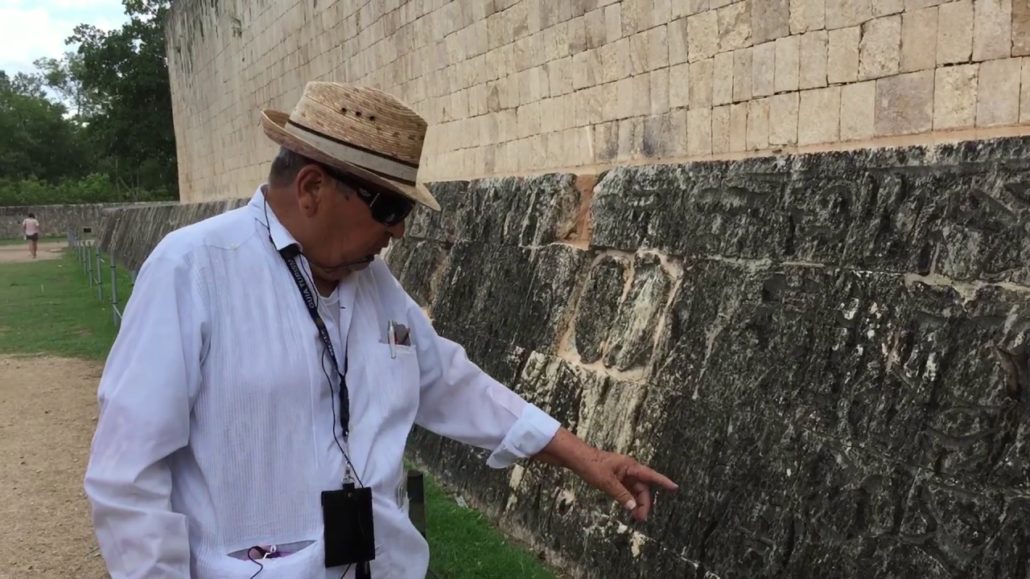
This is why it helps to have someone with a wider wide, who takes a multi-disciplinary approach and who understands the symbolist school of thought leading you through the Yutcan. This of course is only if your desire is to deepen your understanding for the mysteries of the Maya.
The lack of esoteric insights from general tour guides should come as no suprise. Most tour guides are not erudite scholars or deep researchers. They are given only basic data points in their training, thus passing this common knowledge on to you. This is perfectly fine if common knowledge is all that you seek.
However to truly gain insight into the temple teachings we must completely immerse ourselves in the mysteries of the Maya.
It is only through an intensive study where our methodology draws from not only scholarly sources but also the esoteric that we can begin to widen our view. We must lend an unbiased ear to the the oral tradition and make the effort to explore the ruins in order to investigate the remaining evidence in-the-flesh. In this way we can come to develop a deeper understanding and experience first-hand why the ball courts are so important.
The esoteric teaching packs powerful practicalities that can be integrated into our daily and spiritual lives but they are often elusive to the casual tourist.
If you are still reading this – You are NOT the casual tourist!
And if you are anything like me, You have an unquenced thirst for digging deeper and experiencing more.
You will NOT want to explore the ballcourt at Chichen Itza without first understanding its hidden relationship to sound and then experimenting for yourself.
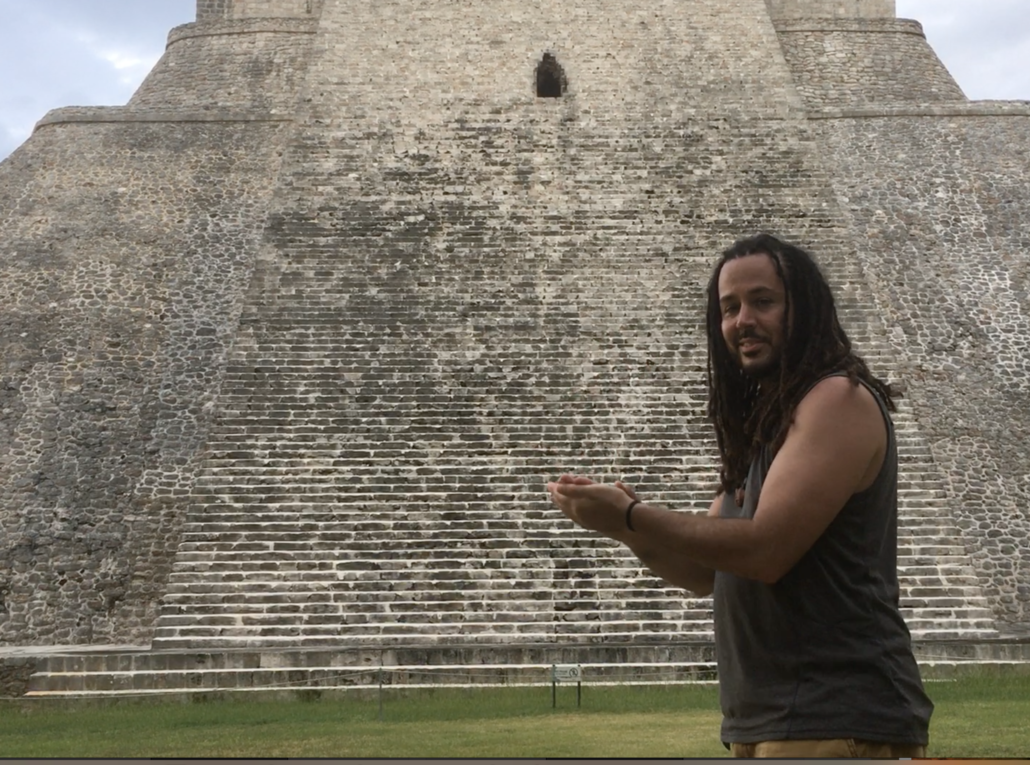

The complexes of the Yucatan are ancient academies consecrated to the cosmos, each with it’s own distinct teachings. Chichen Itza pays homage to a dual deity, the plumed serpent, Kulkukan, who in part symbolizes cosmic wisdom. Like the resplendent Quetzal bird, with its unique chirp and iridescent color scheme, the structures within the plaza place a strong emphasis on the mysteries of sound and light.

At night, Chichen Itza offers an animated sound and light show (we take our tour groups to see it), however the real secret teachings of sound and light occur during the day only if you know where, when and how to look for them.
One example would be the step-pyramid of El Castillo, also known as the Temple of Kukulcan, that dominates the center of the Chichen Itza. Each equinox, thousands of tourists gather to watch the natural light display caused by the rays of the setting sun passing through the steps of the pyramid.
The orientation and inclination of the pyramid causes the light of the setting sun to project a diamond pattern (like that on the back of a rattlesnake) on the staircase. The shadow gives off the appearance of a serpent’s tail which connects with the head of a serpent featured at the bottom of the staircase.
And for sound, if you were to stand in front of the stair case and clap it will produce a familiar echo reminiscent of the unique sound made by the Quetzal bird.

The Maya also demonstrate the importance of sound and light as the mystery of creation in ritual ball game and the construction of the ball court at Chichen Itza.
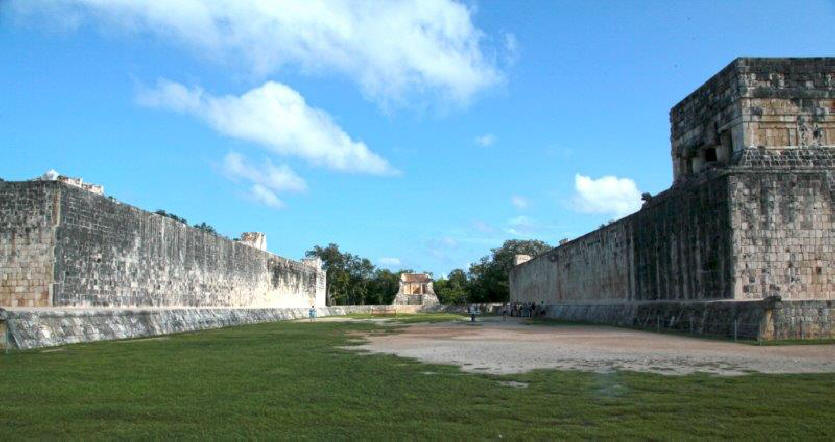
The Secret of Sound
In the beginning of creation was the word. Word is sound and sound is vibration. All is vibration. All is divine mind. This hermetic principle was identified by the Maya mystery school of philosphy hundreds of years before Hermes Trismegistus. The Maya, masters of measure and time already knew the relationship of man with the cosmos and tuned their ball courts to the music of the spheres hundreds of years before Pythagoras began teaching the theory to followers of his mystery school. This is why the ball court was so important. It was meant to teach initiates the significance of creation through the secret of sound and light.

We now know that light can be produced from sound. The scientific term for this effect is called sonoluminescence. It first discovered at the University of Cologne in 1934 as a result of work on sonar. H. Frenzel and H. Schultes put an ultrasound transducer in a tank of photographic developer flud. Their goal was to speed up the development process. To their suprise, they noticed tiny dots on the film after developing and realized that the bubbles in the fluid were emitting light with the ultrasound turned on. There correspondance between audible music and visible light can change our conception of reality.
When considering the scientific fact that Sound is Light at a lower vibration and Light is Sound at a higher oscillation, it becomes evident that all of creation both physical and manifest, spiritual and metaphysical is one absolute unity of great beauty. When one is illuminated with this realization, the intiate comes to know that recall to unity was the sacred goal of the temple priests. A timeless reminder of keeping oneself in balance through understanding our connection to the divine mind.
Let us now begin exploring the Maya Ball Game.
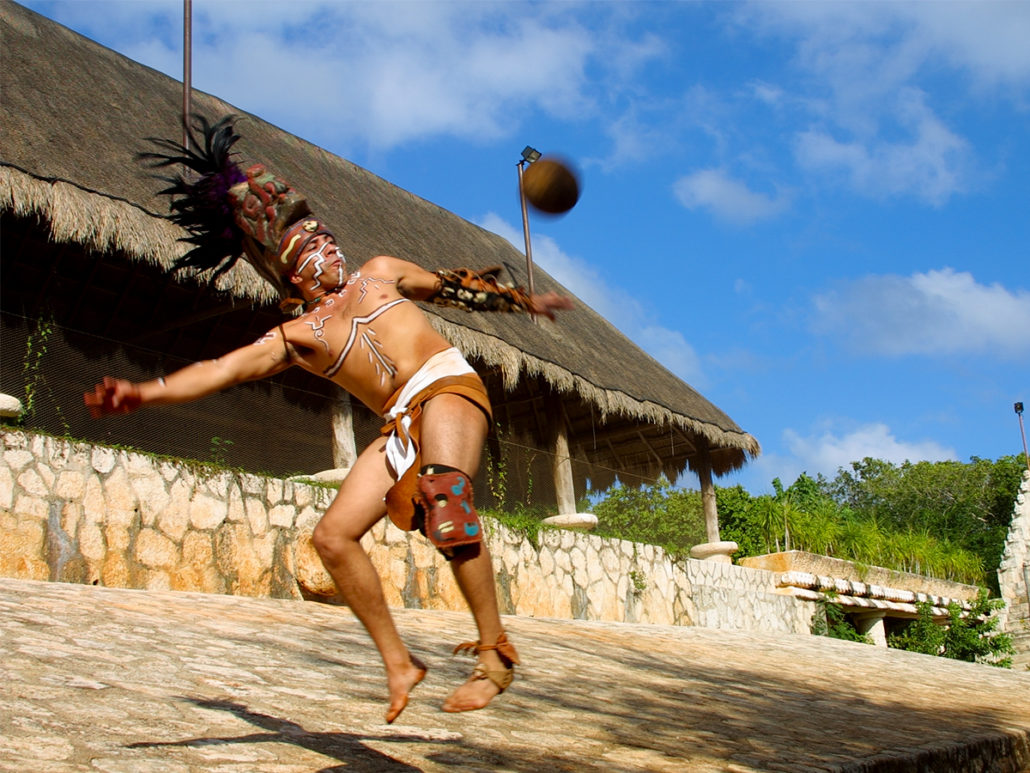
The Maya Ball Game
The Mesoamerican ball game likely originated earlier than 1400 BCE in the low-lying tropical zone, home to America’s mother culture, the so-called Olmec. We do not know what the Olmec called it but what we do know is that the Aztecs continued the tradition and called it tlachtli, or ollamaliztli in their Nahuatl language. For the classic Maya it was called pitz. In English however, it is often called pok-ta-pok (or pok-a-tok). The origins of this term can be traced back to 1932 in a scholarly article by Danish archaeologist Frans Blom, who adapted it from the Yucatec Maya word pokolpok.

Noone is certain exactly how the sport was played or what the rules were. In the most common theory of the game, the players struck the ball with their hips, although some versions allowed the use of forearms, rackets, bats, or handstones. The ball was made of solid rubber and weighed as much as 4 kg (9 lbs), and sizes differed greatly over time or according to the version played. The game was the evident prototype of several of our modern games, a mixture of baseball, soccer, and basketball.
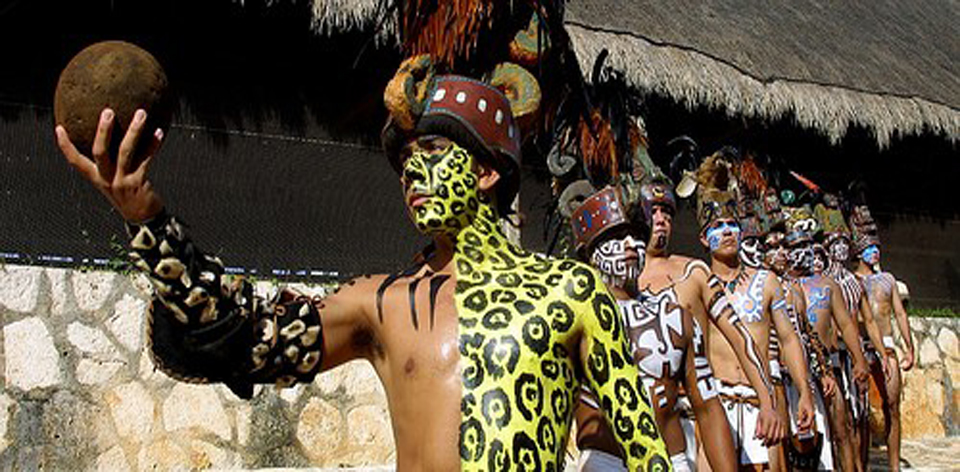
The game had important ritual aspects, and major formal ballgames were held as ritual events. It wasn’t until late in the history of the game, that the Aztec and Maya occasionally seem to have combined competitions with religious human sacrifice. This could be a corruption of the original sport.

The ball courts themselves hold astronomical significance serving as cosmic maps. According to Livio Catullo Stecchini, a professor of ancient history the ball court at Chichen Itza displays on its walls a cylindrical mercator projection of the path of the planets around the zodiac. Other reseachers believe that the bouncing balls thought to have represented the sun while the stone scoring rings are speculated to signify sunrise and sunset, or equinoxes.
A Portal to the Underworld
The games dual nature represented a struggle between day and night, light and dark, The Maya’s Kukulkan and the Aztecs Tezcatlipoca, an on goin battle between life and the underworld, Xibalba. The open air ball courts were considered portals to the underworld and were laid out in precise locations within the central ceremonial plaza. The serpent symbolism is a clue informing us of the sacred space. By playing the game you were interacting within the walls of this sacred space to maintain of the cosmic order of the universe and the ritual regeneration of life.
You don’t have to play the game to experience the fusion of terrestial and cosmic forces that take place inside the ball court at Chichen Itza.
Secrets of the Maya Ball Court at Chichen Itza
There are several secrets connecting sound to the Maya ball court at Chichen Itza. For example the playing alley is engineered in a way so that when you clap it will echo seven times. Keep in mind that the number seven is highly symbolic as in the seven tone diatonic scale, the days of the week, the seven colors of the rainbow, seven primary human chakras etc.
Another acoustic experiment that you can try for yourself. When you whisper into the wall at one end of the ball court, say for example the temple of the bearded man, your partner can hear at the opposite end of the spectrum. Is this a modern anomaly or an ancient feature demonstrating the Mayas requisite knowledge for intentional acoustic design?
In the 1920s, the American archaeologist, Silvanus Morley, who by the way served as the protoype for George Lucas and Steven Speilbergs major motion picture character, Indiana Jones, was first to report a “whispering gallery” at the Great Ballcourt;
“Standing in this temple one can speak in a low voice & be heard distinctly at the other end of the court, 500 feet away.”
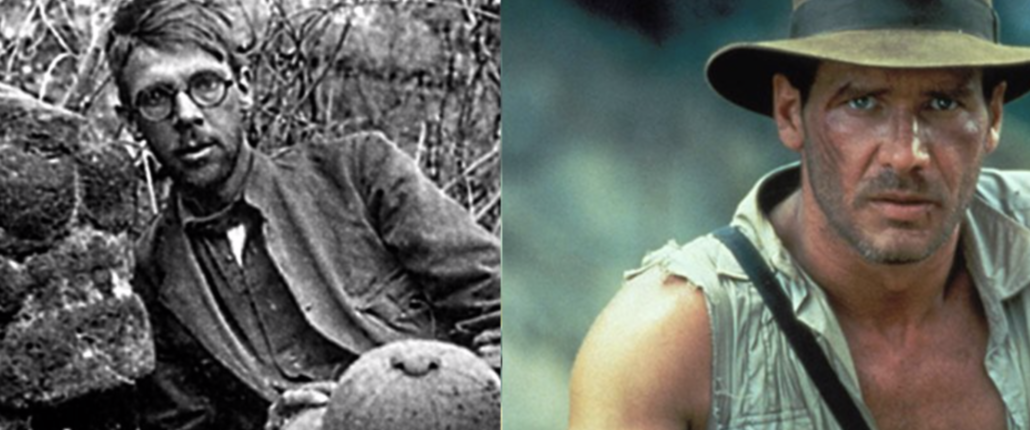
Some modern archaeologists have dissmissed this sonic phenomana as a meaningless artifact of reconstruction or ageing. Yet In 2002 a group study reading conducted by scientiests revealed how the original architecture was already acoustically tuned.
Applying Scwaller de Lubiczs Ancient Egyptian Doctrine to the Maya of Mexico
My research work in Mexico is in part influenced by my mentor, the late John Anthony West, a rogue Egyptologist and a pythagorean, who like his inspiration, R.A. Schwaller de Lubicz believed that through myth, image and geometric proportion, the ancient Egyptians were able to encapsulate in their writing and architecture the basic pattern structures of the natural universe. This got me to thinking, with so many similiarties between both cultures, could this doctrine hold true for the Maya of Mexico?

At the age of thirty, R.A. Scwaller de Lubicz published his first book, A Study of Numbers on the subject of Pythagorean number mysticism. So I took up study in the Pythagorean mystery school tradition.
To understand how the ball courts at Chichen Itza work we can rely on Pythagoras, whose teachings become central for gaining new insight into the metaphysical mathametics and frozen music hidden in the grand ball court at Chichen Itza.
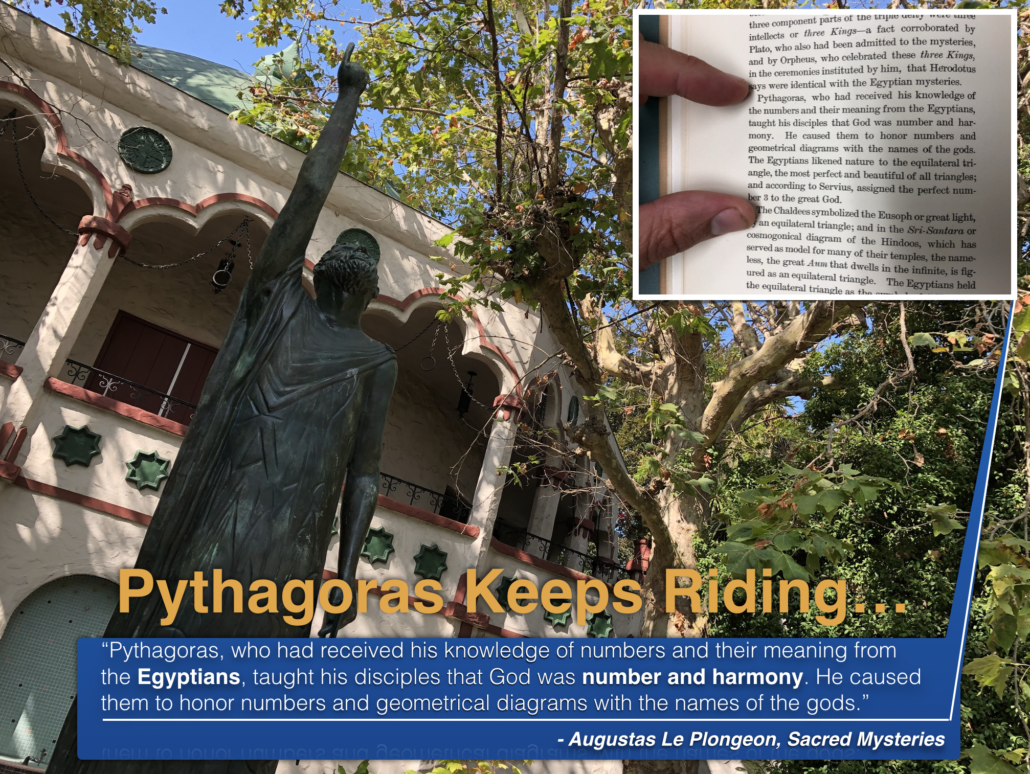
The Greek philospher, Pythagoras was possessed with a penchant for understanding the notes and scales used in music, and he favored a stringed instrument called a Lyre for his experiments. He determined that intervals are defined by the lengths of the strings being in a certain ratio, each with a special role in music harmony.
He first noticed that when two strings that share the same length, tension and thickness, when plucked sound the same. They share the same pitch and produce a harmonious consonant when played together and this relationship, or interval, between the notes is called a unison. This is a 1:1 ratio.
His second observation was of two strings of the same tension and thickness, but of different length, one string being exactly one-half the length of the other string, had a higher pitch but when playe together they still soun consontant. This interval is called an octave. This is a 2:1 ratio.
Finally he noticed a string that is two-thirds the length of the other, the strings would again sound consonant when played together and this relationship between the two notes is called a Perfect Fifth. This is a 3:2 ratio.

What does Pythagoras penchant for music have to do with the Maya Ball court at Chichen Itza?
Well, Whats interesting is that the length-to-width ratio at the ball court of Chichen Itza is a perfect 3.2 ratio. Pythagoras was so pleased with this interval that he called it “Perfect”.
The entire structure is based on musical notation and acoustically tuned in this perfect way not only demonstrating a connection to music, but engineered to invite balance into our being. You do not need to engage in the ball game in order to feel the subtle energy in this sacred space. Sacred architecture may not always explain, but it certainly evokes.
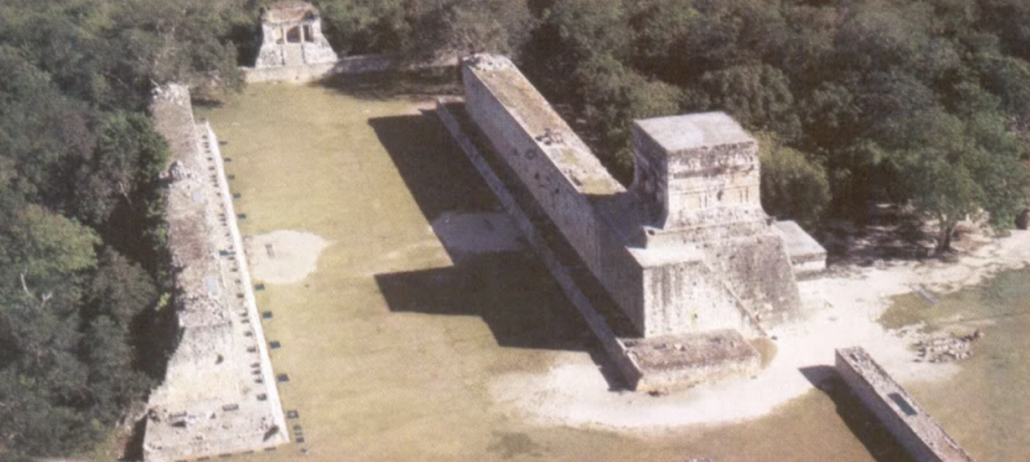
This is the difference between subjective architecture of today and objective architecture of the ancients. It can certainly be experienced but only through an esoteric understanding can it be brought to our level of awareness. What appears to be a sporting complex is in truth a therapeutic theater meant to teach initiates of the Kukulkan degree the mysteries of creation through the secrets of sound and light.

